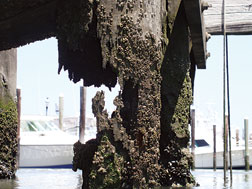 |
| McLaren |
The water quality in major U.S. harbors has improved drastically over the last 15 years thanks primarily to the strict standards established by the federal Clean Water Act of 1972. An unfortunate by-product of that effort, however, is the resurgence of micro-organisms that feed upon submerged wood, commonly called marine borers. These creatures have caused the collapse of dozens of piers in New York Harbor, as well as marine structures on other waterfronts.
Two types of marine borers are responsible for most damage. Limnoria are shrimp-like crustaceans that swarm around piles of wood and eat it from the outside, leaving a distinctive hourglass-shaped pile. The teredo, or shipworm, bores pinholes on the outside a pile and proceeds to grow inside along the length of the pile, with the grain of the wood. A wood pile can be completely infected with shipworms and not be detected from the outside by an untrained eye.
Traditional methods of resisting marine borers include treating the wood with toxic substances such as chromated copper arsenate (CCA), which is used in pressure-treated lumber, or creosote. But the U.S. Environmental Protection Agency is taking measures to ban these materials because they leach potential carcinogens into the water.
Another alternative is to use hardwood from tropical rainforests. It is effective because it is so tough to chew that marine borers go elsewhere. But harvesting this wood leads to deforestation, which is environmentally harmful.
Damaged wooden pilings can be remediated. They can be encased in fiberglass or nylon jackets filled with concrete, but this is expensive. Coated steel jackets can be used, but they corrode and need to be replaced periodically at considerable expense. Tests also have been performed for using plastic wrapping, but this is a temporary solution.
 |
As alternatives have been sought, a recycled plastics industry has taken shape. Polymer physicists at the Center for Plastics Recycling Research at Rutgers University developed a method for creating lumber from recycled plastic and reinforcing it. We helped to introduce this concept to civil engineering and began experimenting with plastic lumber on bridges, decks and docks.
Recycled plastic lumber resists marine borers, corrosion and does not leach toxic chemicals. It also is durable. A common refrain among professionals in the plastics recycling industry is that 50 years from now, old landfills will be mined for plastic because it does not decay.
Recycled plastic lumber is composed of high-density polyethylene —commonly found in milk jugs and shampoo bottles—reinforced with fiberglass. If a pier were to be remediated using treated lumber, the cost would range from $50 to $150 per sq ft, depending on damage. The cost could be double using plastic lumber.
At this stage, only a small number of firms manufacture plastic lumber, partly because of designers’ reluctance to specify the material. To address this issue, we are developing design standards for structural-grade plastic lumber and polymeric piling that will be submitted this year to the American Society for Testing and Materials International, West Conshohocken, Pa. Our aim is simple—to allow other engineers to apply engineering principles to the design of plastic structures.
The need for shoreline stabilization has never been greater and recycled plastic lumber addresses these needs. All that is needed is industry acceptance and investment. If agency chiefs and political leaders marshal support and resources for this initiative, the plastic lumber industry will grow, prices will drop and the material will be a viable option for marine structures.

Post a comment to this article
Report Abusive Comment